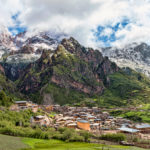Here are 8 tips on how to how to stay well at altitude:
1.) Train, train, train
It is often not practical to prepare by actually spending time up high, but you cantrain your heart and lungs for altitude, even at sea level. Do at least four hour-long sessions per week of full-effort aerobic exercise, such as running, biking or swimming. Find steep hills to climb wherever you can. And if you will be carrying a load, include this into your training regime.
2.) Rest
If you will be flying or driving to altitude, the first thing you must do is rest. Spend two or three days doing as little as possible and drinking plenty of water – around four to six liters of water per day. Dehydration worsens altitude problems, as does drinking alcohol.
3.) Keep eating
You may lose your appetite when first at altitude, but it is important to keep eating. You will burn more calories even at rest when up in the alpine cold: make sure you eat plenty of high-carb, slow-burning energy foods.
4.) Climb high, sleep low
When ascending above 3,000m, if the geography allows, do not ascend more than 300m a day. If you do, plan to sleep no more than 300m higher than you did the previous night until you are well acclimatized. Acclimatization takes one to three days for any given altitude.
5.) Tough days, rough nights
Nights may be tough at first. Breathing rate slows when you sleep and you may wake frequently feeling short of breath. Propping yourself up with your backpack to sleep half-sitting may help.
6.) Know the danger signs
It is normal to have some headaches when you are first above 2,500m. Rest, drink and medicate as you would at sea level. Breathlessness is normal on exertion at altitude – but above 3,000m, watch for breathlessness when resting. A cough; a severe, persistent headache; nausea; loss of coordination or disorientation all are signs of Acute Mountain Sickness (AMS). This potentially fatal condition demands rapid descent.
7.) Have a plan
AMS symptoms often improve with a descent of 300 to 600m. Make sure your walking party has a plan of action for descent.
8.) Try folk (and Western) remedies
Andeans have chewed coca leaves for thousands of years — the alkaloids released relieve altitude symptoms. In the Himalayas, dried yak cheese is said to alleviate some altitude woes. Eating steak before arriving at altitude may increase iron levels and help produce blood cells to transport oxygen. Or take the pharmaceutical route: Acetazolamide (Diamox)before and during ascent helps acclimatization.
High Altitude Journeys in Tibet
Now that you are prepared, here are 3 of the most beautiful — and challenging — high altitude journeys in Tibet:
Mt Kailash Kora, Tibet
The faithful (and fit) make the 52km circumambulation in one day, but most trekkers take at least three days to circuit the mountain at altitudes of between 4,570 and 5,790m. Be glad you are not prostrating at every step like some pilgrims.
Everest Base Camp, Tibet
See the world’s highest mountain in one of the best overland drives between Lhasa and Mount Everest
Trekking Nangchen
This is by far one of the wildest and most undiscovered parts of the Tibetan Plateau.
We promise – you won’t see any other foreign tourists out here (although you may see Tibetan Antelope, blue sheep, and lots of yaks and marmots!)







